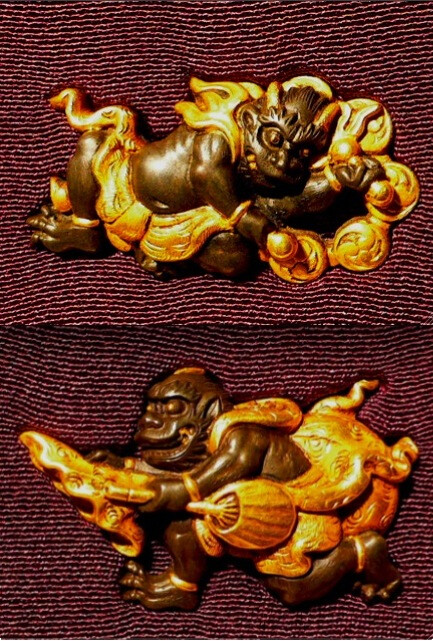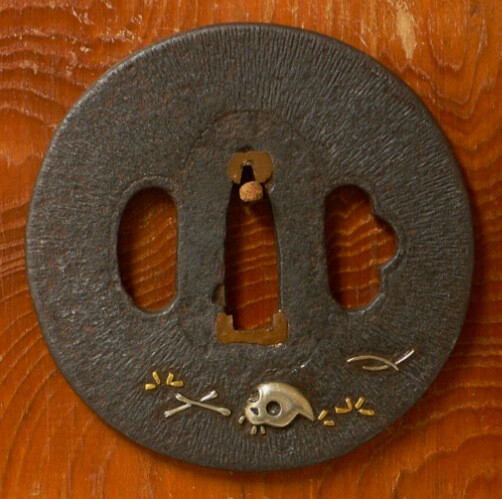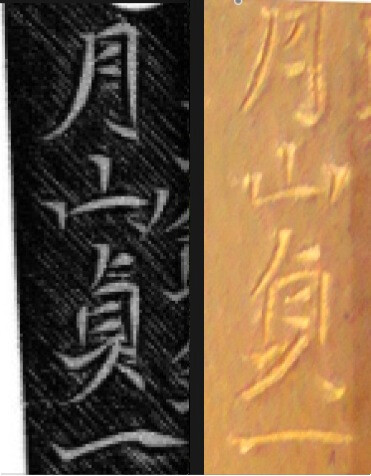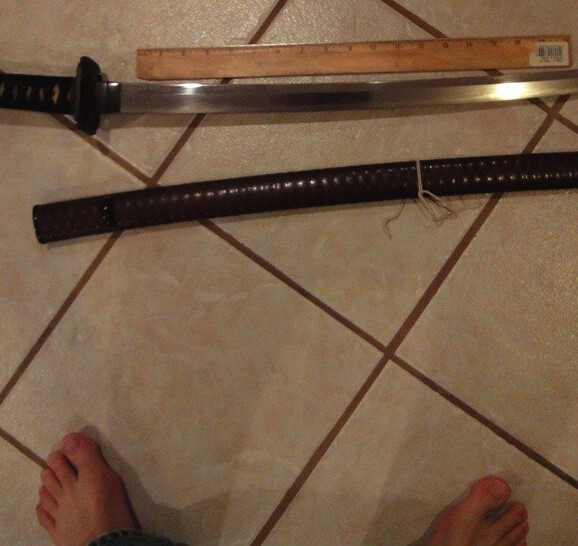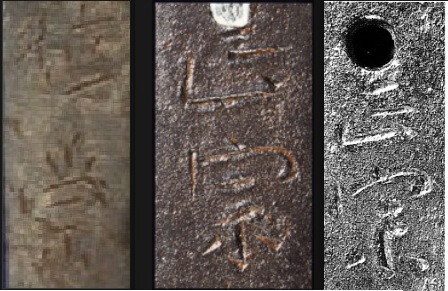-
Posts
779 -
Joined
-
Days Won
1
Content Type
Profiles
Forums
Events
Store
Downloads
Gallery
Everything posted by reinhard
-
Quite right. The origami says: katana / kin-zogan-mei / Magoroku Kanemoto/ Daiei(era) / Mino(province) This leaves no room for interpretation. Since it is quite clear this is NOT Seki-no-Magoroku's work, I was wondering where these papers come from (thanks for the link, Thierry). Many of the possible objections against a Magoroku-attribution have been mentioned. Good job. Additionally I would like you to focus on the qualities of kin-zogan-mei more. This one seems to be of bad quality and was made no earlier than Meiji times, probably even later. Kin-zogan-mei are easy to apply, but they are also revealing much about the maker and the time when they were made. Unfortunately many people (especially Westerners) are loosing their cool when seeing gold, even if it's just a tiny amount on a nakago. "Where there is gold there must be something precious". Fraudsters knew and know about this. Selling worthless claims by presenting gold-covered pieces of lead as real nuggets worked the same. Anyway, nidai KANEMOTO is a legend. From the days of warfare in Muromachi times to Yukio Mishima's seppuku in 20th century: Every samurai in the past wanted and every would-be samurai at present would like to possess a saijo-o-wazamono by Seki-no-Magoroku. Forgeries in his name and false attributions are countless. reinhard
-
Show us the opposite side of this obscure certificate, if you please. reinhard
-
These menuki were shown during a special exhibition in Atsuta Jingu in 1994 together with some of the finest examples of Tosogu. Like I said: The pics in the catalogue are not very good and cropping didn't do them a favour. Pic is just to illustrate there are peacock menuki. It was a common design especially in the Ishiguro school. Here's the original comment: reinhard
-
Clive, peacocks are not uncommon a subject for menuki. First attachement shows an example by Goto TEIJO. Sorry for the bad quality. It's the scan of an illustration from a catalogue.. Thomas (Helm), you've stated that Raijin and Fujin are rare subjects for menuki. Well, they're not that rare. Second attachment shows the best pair I've seen so far. It is attributed to Yokoya SOYO. The "skull and bones"-theme lasted for a long time. It never became really popular though. Third attachment shows a tsuba from late Edo/ Meiji period. reinhard
-
It would take us more than one bottle of Whiskey to talk this over. reinhard
-
Veli, All I can say on the basis of your pics is: This is a very interesting sword. Have it checked carefully by a reliable expert IN HAND. Shape, condition and surface details look interesting. Forget about the utsuri-discussion so far. Some statements were accurate and others were just half digested theories. Utsuri is one of the most complex and demanding features of NihonTo. It cannot be appreciated or even understood on the basis of pictures; and BTW: utsuri is still just one feature among many others. Many people start focussing on Bizen province immediately when hearing of utsuri. That's the first mistake. Many people have theoretical ideas about utsuri without knowing real examples. That's the second mistake. Some people are seeing utsuri where there is none. That's the third mistake. Some people can't see utsuri even if it's just in front of their eyes. That's the fourth mistake. I can't tell you for sure, if there's utsuri on your blade or not, but there are many other features worth looking at. For the utsuri-afficionados out there: Here's a sample of a blade by Ichimonji SANETOSHI (Bizen province). Utsuri is highly irregular. It looks as if this kind of utsuri correlates to the one of Aya-no-Koji SADATOSHI (Yamashiro province). Extensive studies have been made. Ever heard of them? reinhard
-
Are you kidding me? This is one of the poorest (photo shop) jobs I've seen in a long time. You didn't even care about pixel sizes, shadows and proper framing (pun intended). I don't care where you got your pics from. I don't care wether this obscure object belongs to you or not. I'm just wondering why you are insisting on being the owner of TWO of these hideous objects. In your place, I'd be eager to proof I'm NOT owning junk like this. Sad enough this kind of crap is seriously discussed on a board dedicated to NihonTo. reinhard
-

Request for Assistance with Yari Nengo Translation...
reinhard replied to aeguy's topic in Translation Assistance
nengo is: Tenmei san-nen.....(1783) reinhard -
You got me wrong. It looks as if you posted two different pics of one and the same object. This becomes obvious when comparing them to the background. The objects have the exact same size and are placed on the exact same spot on the tissue. In fact, so exactly in the same positiion it is beyond coincidence. Actually it looks as if the same pic was just edited in completely different ways. It doesn't really matter much, for this thing is far from real Tosogu anyway. Maybe I'm wrong. I was just wondering. Could you show us the two objects in one shot, please? reinhard
-
-
Check: Japanese Swords and Sword Fittings from the Collection of Dr. Walter Ames Compton, Part II Christies NY, 1992, Lot No. 203 reinhard
-
Accuracy and fidelity are not unknown in Hollywood. It's just that they don't matter much in Hollywood's business plans. Since making movies for the big screen has turned into a multi-million dollar investment, Hollywood handed over movie-making to accountants and lawyers. That's why most of Hollywood's movies are so incredibly boring and predictable from the start. It takes quite a calibre to enforce accuracy of details at least, not to speak of historical accuracy. Stanley Kubrick was quite successful with "Barry Lyndon", f.e., no matter how accurate Thackeray's novel looks like from a Historian's perspective. Martin Scorcese is trying to smuggle accuracy and fidelity of details into his pictures and is doing quite well. Ridley Scott didn't, nor will he give history lessons, but the glasses in "Gladiator" looked at least like Roman glass. I thank him for that and for two hours of good entertainment. That's what Hollywood is good for at its best. There is nothing else to expect. Definitely no history lessons. Last, but not least. See "Tasogare Seibei" ("Twilight samurai"). It will give you a feel for samurai culture like no other movie. reinhard
-

origami translation help needed - nice old blade
reinhard replied to b.hennick's topic in Translation Assistance
Barry, the NTHK paper is attributing an unsigned blade to the school of Hokke Ichijo, made during Oei era in Bingo province. This is definitely not the blade you are presenting. reinhard -
-
deleted
-
deleted
-
-
Max, I don't think the hamon was "drawn in". The blade was mistreated by an amateur and left at an early stage of the polishing process. During polishing the hard Ha is shining darker than the softer Jigane, for the polishing stones leave smaller marks on the hard steel of the edge than on the softer rest of the body. This effect is reversed by kesho-technique, i.e. using thin wafers of uchigumori stones in a particular way during the final stage of polishing, thus masking the naturally darker Ha. Added pic shows the four final stages of polishing (top to bottom) done by a craftsman. In order to find out if there is a real hamon or not, you need to hold the blade pointing towards a single light bulb. Then look at the Ha from a shallow angle. There should be a milky, white line between the hardened edge and the rest of the blade. reinhard
-

Have you all seen this
reinhard replied to Mark Green's topic in Auctions and Online Sales or Sellers
Like I said. It is just a notion. reinhard -

Have you all seen this
reinhard replied to Mark Green's topic in Auctions and Online Sales or Sellers
Dear Moriyama-san, It's good to see you still believing in the good of men, but this time you are stretching freedom of interpretation a little too far, I'm afraid. There is no TSUNEMASA to be found in reliable compilations of kaji anywhere, not to speak of one using this particular title/rank. The way these kanji are chiselled are way beyond of what could be excused by "illiterate", "rural", "ignorant" or whatever. It's just a fake signature. Added is a pic illustrating why I think there is another (fake) mei underlying. reinhard -

Have you all seen this
reinhard replied to Mark Green's topic in Auctions and Online Sales or Sellers
It's just a notion, but these two kanji are reminding me of a fake "Masamune"-mei turned into something less decipherable and a fraud less easy to detect. reinhard -
mei reads: SENJUIN reinhard
-

Have you all seen this
reinhard replied to Mark Green's topic in Auctions and Online Sales or Sellers
-




